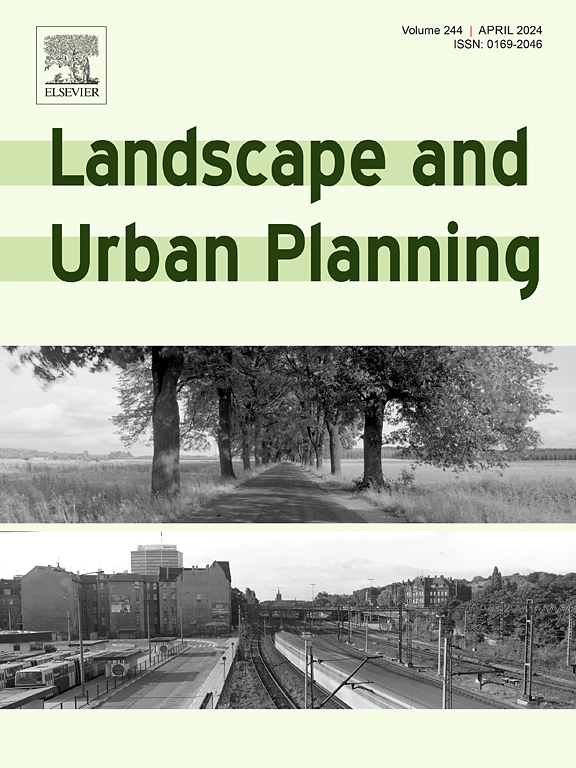增强城市绿色基础设施的降温效果:对中国 310 个城市的互动影响和优化路径的实证分析
IF 9.2
1区 环境科学与生态学
Q1 ECOLOGY
引用次数: 0
摘要
城市绿色基础设施(UGI)是一种有效的基于自然的城市可持续发展解决方案,对于应对普遍存在的城市热岛效应也至关重要。然而,如何通过优化空间格局(如城市层面的结构和网络)来增强其降温效果却很少受到关注。以中国310个城市为研究对象,探讨地表热流指数的多维特征及其对地表热流的交互和联合影响,以确定特定气候背景下地表热流的优化降温路径。其中,UGI模式的八个维度,即数量、斑块大小、形状复杂性、碎片化、邻近性、多样性、结构和连通性,每个维度都使用一个代表性度量。在考虑气候背景的潜在调节作用的基础上,利用结构方程模型研究了UGI影响SUHI的复杂途径。结果表明,UGI通过多种途径影响SUHI,每种途径覆盖了不同的UGI特征,其影响方向和程度各不相同。在所有途径中,直接影响超过间接影响,间接影响的效果在很大程度上被多重复杂和相互抵消的中介效应所削弱。覆盖、邻近、结构和连通性是主要的降温特征,而后两个维度在很大程度上被以往的研究所忽视。其中,连通性尽管在直接路径中发挥了主导作用,但由于以往规划实践中考虑有限和执行不力,一直处于较低水平。一般来说,在UGI覆盖相同的情况下,集群结构和连通网络较多的城市SUHI强度相对较低。对于大多数城市来说,这种增强的降温效益可以通过更小的斑块、更复杂的形状和更短的斑块间距离来实现。而对于炎热问题较为严重的热带、亚热带城市,建议优化UGI设计,采用简单、规则、分散分布的斑块。本研究将如何配置UGI以增强冷却效果的理解从地方扩展到城市层面。研究结果可能有利于追求气候适应型城市的城市规划者。本文章由计算机程序翻译,如有差异,请以英文原文为准。
Enhancing the cooling effect of urban green infrastructure: An empirical analysis of interactive impacts and optimizing pathways over 310 Chinese cities
Urban green infrastructure (UGI), an effective nature-based solution for urban sustainability, is also crucial in coping with the prevalent urban heat island (UHI) effect. However, how to enhance its cooling effect through optimized spatial patterns (e.g., city-level structure and network) has received little concern. Based on 310 Chinese cities, this study explored the multi-dimensional features of UGI and their interactive and conjoint impacts on surface UHI (SUHI) to identify the optimized cooling pathways under specific climatic backgrounds. In particular, the patterns of UGI were characterized by eight dimensions, i.e., quantity, patch size, shape complexity, fragmentation, contiguity, diversity, structure, and connectivity, each using one representative metric. Then the complex pathways of how UGI affected SUHI were investigated using the structural equation model, with the potential moderating role of climatic backgrounds taken into consideration. Results revealed that UGI affected SUHI through diverse pathways, and each pathway covered discrepant UGI features with various influencing directions and magnitudes. Among all pathways, direct impacts surpassed indirect ones, whose performances were largely diminished by multiple complex and counteracting mediation effects. Coverage, contiguity, structure, and connectivity, with the latter two dimensions largely neglected by previous studies, were found to be the primary cooling features. Among them, connectivity, despite its dominated impact in direct pathways, remained at low levels due to limited consideration and poor execution in previous planning practices. Typically, with the same UGI coverage, cities equipped with more clustered structure and connected network exhibited relatively lower SUHI intensity. For most cities, such enhanced cooling benefits can be achieved through mediation effects by smaller patches, more complex shapes, and shorter inter-patch distances. For cities in tropical and subtropical regions facing severer heat issues, however, it is recommended to optimize UGI design by adopting simple and regular patches with scattered distribution. This study extended the understanding of how to configure UGI for enhanced cooling effects from local to city level. The results may benefit urban planners pursuing climate resilient cities.
求助全文
通过发布文献求助,成功后即可免费获取论文全文。
去求助
来源期刊

Landscape and Urban Planning
环境科学-生态学
CiteScore
15.20
自引率
6.60%
发文量
232
审稿时长
6 months
期刊介绍:
Landscape and Urban Planning is an international journal that aims to enhance our understanding of landscapes and promote sustainable solutions for landscape change. The journal focuses on landscapes as complex social-ecological systems that encompass various spatial and temporal dimensions. These landscapes possess aesthetic, natural, and cultural qualities that are valued by individuals in different ways, leading to actions that alter the landscape. With increasing urbanization and the need for ecological and cultural sensitivity at various scales, a multidisciplinary approach is necessary to comprehend and align social and ecological values for landscape sustainability. The journal believes that combining landscape science with planning and design can yield positive outcomes for both people and nature.
 求助内容:
求助内容: 应助结果提醒方式:
应助结果提醒方式:


